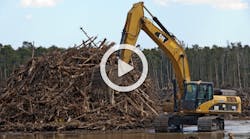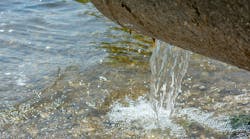Implementation of an Effective Erosion Control and Stormwater Management Enforcement Program in Washington, DC
The District of Columbia recognizes that an effective erosion and sediment control and stormwater management enforcement program is essential to mitigate damage to the aquatic resources of its streams and rivers by sedimentation and polluted runoff. In 1998, the Environment Health Administration (EHA) instituted a realignment plan to strengthen its enforcement activities.EHA’s Watershed Protection Division created a separate inspection and enforcement program for erosion and sediment control and stormwater management. Before this realignment, technical plan reviews, environment permit issuance, inspections, and enforcement were administered under the same program. Under the realignment plan, a separate program implements the inspection and enforcement components of the soil erosion and sediment control and stormwater management regulations.
Installation of stormwater BMPsIn an effort to streamline enforcement of these regulations and ensure compliance, new standard operating procedures (SOPs) were developed and implemented, providing a consistent framework for conducting inspections and issuing notices of violations, civil infraction fines, and stop-work orders (SWOs) for violations of the regulations. Civil infraction fines range from $50 to $4,000, depending on the nature of the infraction or whether the violator is a repeat offender. Enforcement procedures stipulate that violations of stormwater management regulations are misdemeanors punishable by fines of at least $2,500 but no more than $25,000.The program ensures compliance with the regulations by inspecting the installation of best management practices (BMPs), monitors and directs maintenance and adherence to design standards and specifications during construction, and authorizes the removal of temporary controls as construction sites are permanently stabilized. The District of Columbia also has instituted an aggressive maintenance program to ensure that permanently installed stormwater management BMPs continue to function properly throughout their design life. Inspectors have the same enforcement tools for BMP maintenance as they do for construction.The new inspection and enforcement program has been extremely effective in obtaining higher rates of compliance from the building industry over the last two years. During fiscal year 2000, 184 enforcement actions were taken for violation of erosion and sediment control and stormwater management regulations. This has resulted in fewer citizen complaints than during the same period in the previous year. BackgroundSoil erosion and sediment control and stormwater management have been of concern to the District of Columbia government for many years. A soil erosion and sediment control program was established in 1974 to reduce sediment pollution to the district’s streams and rivers. Regulatory authority for this program was established through the enactment of soil erosion and sedimentation control law in 1977 and subsequent governing of regulations. The law was amended in 1994 to remove the exemption of federal properties granted under the previous laws and also give regulators stop-work authority. The District of Columbia developed a stormwater management program in 1984 as part of its commitment to the 1983 Chesapeake Bay Clean-up and the 1984 Anacostia River Restoration Strategy Agreements, helping restoration efforts being undertaken in these two water bodies. Stormwater management regulations were developed in 1988 as part of the District of Columbia Water Pollution Control Act. The primary objective of both programs is to control nonpoint-source pollution. This is accomplished by ensuring, through a regulatory mechanism, that the construction industry controls both quality and quantity of urban runoff from construction sites through BMPs. In addition to regulations, the District of Columbia developed a soil erosion handbook and a stormwater management guidebook distributed to engineers, architects, and building contractors. The purpose of these documents is to provide guidelines for the effective implementation of erosion and sediment control and stormwater management measures in accordance with the regulations. A document containing standards and specifications is disseminated to designers and provides measures to control sediment from construction activities.Program AdministrationInitially the erosion and sediment control and stormwater management programs were administered separately within the Department of Consumer and Regulatory Affairs (DCRA). Both programs were relocated from DCRA to the Department of Health in January 1998 along with other environmental programs under EHA.As part of a realignment plan in November 1998, EHA created a separate inspection and enforcement program for erosion and sediment control and stormwater management within the Watershed Protection Division (WPD). The purpose of the new program is to strengthen compliance for the District of Columbia’s soil erosion and sediment control and stormwater management regulations in an effort to fulfill its commitments to clean up the Chesapeake Bay watershed.Under the realignment plan, the inspection and enforcement program is responsible for the inspection and enforcement component of these regulations as well as for the investigation of citizens’ complaints relating to soil erosion and drainage problems. The program ensures compliance with the regulations by inspecting the installation of BMPs and by monitoring and directing maintenance and adherence to design standards and specifications during construction. It also authorizes the removal of temporary controls as construction sites are permanently stabilized. WPD has also instituted an aggressive maintenance program to ensure that permanently installed stormwater BMPs continue to function properly throughout their design life.Program Development and ImplementationThe overall goal of this program is to coordinate, facilitate, manage, and plan activities to protect the water quality and aquatic resources in the Potomac and Anacostia watersheds by developing and implementing an efficient and effective inspection and enforcement program in support of the regulation of land-disturbing activities. To achieve this goal, WPD assessed the program after the 1998 realignment, then prepared and implemented a five-year strategic plan. The plan highlighted the following critical components in which improvements were needed: hiring of additional inspectors, developing and implementing a formal stormwater management maintenance program, strengthening the enforcement authority of existing regulations, and developing new operating guidance. Five new inspectors have been hired since 1998, significantly increasing enforcement capability. The other program improvement components are discussed below.Stormwater Management Maintenance ProgramSince the inception of the stormwater management program, more than 600 facilities or BMPs have been installed at new development and redevelopment projects throughout the district. These BMPs are used for nonpoint-source pollution control, and hundreds more have been approved for ongoing development projects. Because of the high cost of land and lack of space, most of these stormwater BMPs are installed beneath impervious surfaces such as parking lots and sidewalks and are generally not visible. Initially the District of Columbia did not have a formal program for stormwater BMP maintenance. As in most other jurisdictions throughout the United States, the primary focus was on the construction and installation of BMPs to meet regulatory requirements. That changed in 1999 when WPD developed and implemented an aggressive stormwater management facilities maintenance inspection program. Strengthening Enforcement AuthorityThe District of Columbia enacted the Civil Infractions Law (D.C. Law 6-42) in 1987 to strengthen enforcement of existing regulations. Under this law, inspectors are authorized to impose fines for each violation of the regulations. Initially the soil erosion and sediment control and stormwater management regulations were not included in the law; however, a subsequent amendment includes these regulations and is being implemented. WPD also updated the Civil Infractions Schedule of Fines for Soil Erosion and Sedimentation Control and Stormwater Management, which has been in place since December 1999. Enforcement capabilities were further strengthened through the implementation of SWO authority included in the Soil Erosion and Sedimentation Control Amendment Act of 1994.General Operating GuidanceAs part of the program development and implementation, WPD developed new SOPs for inspection and enforcement to provide a consistent framework for inspections and for issuing notices of violations, civil infraction fines, and SWOs. These are violations of the District of Columbia’s soil erosion and sediment control and stormwater management regulations. Three enforcement remedies can be used to respond to violations. They are, in increasing order of severity, notice of violation (NOV); notice of infraction (NOI), the civil infractions ticket with the fine; and the SWO.In determining which remedy to select, inspectors consider the nature and severity of the violation(s), the urgency with which remedial activity must be taken, whether the violator has taken good-faith measures to come into compliance, and whether the violation is a repeat offense.In most cases, good communication can foster compliance and maintain goodwill without the need to resort to an NOI or an SWO. It is important to develop such communication early on, during the plan review and approval stage, and in the course of regular site inspections.To ensure that WPD uniformly imposes enforcement remedies and penalties for violations of the erosion and sedimentation control and stormwater management regulations, the SOP groups the types of violations likely to be encountered into the following six tiers:Emergency situationsFailure to obtain a permitFailure to correct a violation/problemFailure to comply with approved plansFailure to notify WPD before construction beginFailure to meet other technical requirementsTo help apply the three enforcement remedies appropriately, this SOP provides a “toolkit” of forms:An NOV formA large version of the SWO form for posting on-siteA mailed version of the SWO formAn SWO appeals formA violation referral formAn NOIA corrective action form (CAF)An erosion and sedimentation control site inspection checklist and/or inspection report A stormwater management site inspection checklist and/or inspection reportNotices of ViolationThe NOV is the least severe enforcement remedy. It is usually used for first-time offenders and is the first step in a potentially escalating series of enforcement actions. Used alone, an NOV is an effective way to alert the site owner/contractor that a violation has occurred, provide information about the measures necessary to attain compliance, and indicate the time period in which compliance must be achieved.The inspector issues the NOV immediately upon noticing a violation of the soil erosion and sedimentation control plan, stormwater management plan, or other requirements in the course of a site inspection.When issuing an NOV, the inspector provides the site owner/contractor with the standard NOV form, including the following information:The date, time, and type of inspection during which the violation(s) was observedThe location of the violation(s) (i.e., the site address)The name of the owner/contractorCitation to the law or rule that the owner/contractor allegedly violatedThe action necessary to correct the violation(s)The date and time by which compliance is requiredNotification that failure to take the measures specified will result in further enforcement actionNotification of the site owner/contractor’s right to contest the NOVThe name and telephone number of the inspectorThe standard time for complying with an NOV is 15 calendar days from the date it was issued. The inspector has discretion to lengthen or shorten this period, depending on the extent of the violation and the likelihood of harm to the environment from continued noncompliance. Whenever possible, the inspector provides the NOV directly to the site owner/contractor at the time of the inspection, also giving the operator a verbal summary of the results of the inspection, the nature of the violation(s), and the contents of the NOV. The inspector’s statements and demeanor should make it clear that his/her objective is to prevent harm to health, property, and the environment and to gain compliance with district regulations, not to take enforcement action for enforcement’s sake.In some cases it is not possible to present the NOV to the owner/contractor in person, either because he or she is not available or because of a potentially adversarial or hostile atmosphere on the site. In such cases, the NOV should be sent to the site owner/contractor by certified mail, return receipt requested; if the owner/contractor fails or refuses to accept certified mail, the NOV may be served by regular first-class mail as long as the address can be verified.The site owner/contractor may object to an NOV involving violations of the Water Pollution Control Act on technical grounds by filing a written statement within 15 days after service of the NOV (or longer at the chief of inspection and enforcement’s discretion), stating the grounds for the objection. Filing an objection within 15 days overrides the deadline for compliance stated in the NOV.The inspector must reinspect the site to verify abatement of the violation(s). During the visit, the inspector must summarize the reinspection on the appropriate form or inspection report, noting the status of compliance with each pending item.Civil Infractions NOIThe NOI imposes an immediate financial penalty for violating the soil erosion and sedimentation control and stormwater management regulations. The regulations identify five classes of infractions with associated penalties, as shown in Table 1.Table 1. Classes of Civil Infractions FinesClass Offense Fine (per offense) Class 1First $1,000 Second $2,000 Third $4,000 Fourth and subsequent offenses $8,000 Class 2 First $500 Second $1000 Third $2,000 Fourth and subsequent offenses $4,000 Class 3 First $100 Second $200 Third $400 Fourth and subsequent offenses $800 Class 4 First $50 Second $100 Third $200 Fourth and subsequent offenses $400 Class 5 First $20 Second $40 Third $80 Fourth and subsequent offenses $160 Under these regulations, each type of violation is assigned to a class. Most of the violations that arise under this program fall within either Class 3 or Class 4. Class 2 violations are the failure to obtain an appropriate permit and the failure to comply with an SWO for land-disturbing activity and for stormwater management. There are no identified Class 1 or Class 5 infractions for violations of soil erosion and sedimentation control or stormwater management requirements.As shown in Table 1, the schedule of fines provides for a doubling of the amount of the fine with each repeat infraction. The regulations define “repeat infraction” as a violation by the same person of the same requirement within the same three-year period as the original infraction. “Three-year period” is a calendar period such January 1, 1997, to December 31, 1999; January 1, 2000, to December 31, 2002; and so on.The same violation by the same contractor—even if it involves a different employee or agent—at a different site qualifies as a repeat infraction if it occurs within the same three-year period as the original infraction. When issuing an NOI, the inspector must use the department’s standard form and include the following based on the inspection and the infraction(s) observed:The name and address of the person responsible for activity at the site. This person is legally the “respondent” and is referred to as the “owner/contractor” in the NOIThe nature, time, and place of the violation(s)The date of the hearingCitation to the law and/or rule allegedly violatedThe amount of fine applicable to each infraction and the total amount of the finesAny other information required by the chief of inspection and enforcementThe NOI may be served either in person or by certified mail. If served in person, it may be served at the site to the owner/contractor or his or her agent or delivered to the last known home or business address of the owner/contractor and left with a person older than age 16 living or working there. If it is served by mail, the owner/contractor must answer the NOI within 15 days by submitting the answer form on the back of the NOI. There are three possible responses: Admit the infraction (and pay the fine within 15 days)Admit the infraction with explanation (which means that the owner/contractor is requesting adjudication by mail)Deny commission of infraction and confirm the prescheduled hearingIf the inspector observes a repeat infraction before the owner/contractor admits guilt and pays the fine or before the administrative law judge issues a decision on the infraction, the inspector may issue and serve an amended NOI.At the inspector’s discretion, the inspector may issue a CAF in conjunction with the NOI to impart information about the nature of the violation(s) and the actions necessary to come into compliance.If the site owner/contractor admits, admits with explanation, or is found by an administrative law judge to have committed civil infractions, both the site owner/contractor and the inspector are responsible for verifying abatement.The site owner/contractor must certify that he or she has abated each infraction listed on the NOI. The inspector may request any information necessary to verify that the infraction has been abated and may ask the owner/contractor to complete a Notice of Verification, which contains detailed information on the abatement actions taken.The inspector is responsible for monitoring and verifying the abatement of all infractions and must visit the site as necessary to verify abatement. If the owner/contractor fails to answer the NOI within 15 days of service, the inspector must issue a second NOI, which includes notification that, in addition to payment of the original fine, the owner/contractor must pay a penalty equal to the amount of the previous NOI.If the owner/contractor fails to answer the second NOI within 15 days, the penalty is doubled. The owner/contractor’s license or permit also may be suspended.Stop Work OrdersAn SWO is generally considered the most extreme enforcement remedy available because it requires cessation of all site work, except what is necessary to correct the violation(s), and therefore can impose significant inconvenience and/or cost. For this reason, an SWO should be used only in cases when there is an immediate environmental or health and safety threat, work is being conducted without an approved plan, or other remedies have failed to correct the violation(s).To issue an SWO, the inspector generally must first obtain the approval of the chief of inspection and enforcement. If the chief is not available, the inspector may issue the SWO and seek approval immediately afterward.After obtaining approval, the inspector completes two SWO forms: a large one to be posted at the site and a small one for delivery to the site owner/contractor. Both forms contain the same information:The name and address of the owner/contractorThe project number or permit number for the siteThe nature, time, and place of the violation(s)Citation of the law or rule that the owner/contractor allegedly violatedCorrective action required to return to complianceClear notification that work at the site is to cease until compliance is achievedThe inspector must post the large form in the most conspicuous location on the site, notifying all concerned (including the public and the police department) that the site has been closed.The small form and a copy of the SWO appeals form should be presented to the site owner/contractor, in person if present, along with a verbal description of the violation(s), the fact that the operation is closed, the steps necessary to correct the violation(s), and the owner/contractor’s right to appeal. The site operator must sign to confirm receipt of the SWO. The inspector must document the details of the event including, when possible, the names and addresses of the persons present.If the owner/contractor is not present, if theinspector encounters or suspects a hostile interaction, or if there are other reasons the SWO cannot



